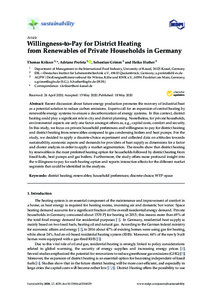Willingness-to-Pay for District Heating from Renewables of Private Households in Germany
| dc.date.accessioned | 2020-06-30T12:20:15Z | |
| dc.date.available | 2020-06-30T12:20:15Z | |
| dc.date.issued | 2020-05-18 | |
| dc.identifier | doi:10.17170/kobra-202006301382 | |
| dc.identifier.uri | http://hdl.handle.net/123456789/11614 | |
| dc.description.sponsorship | Gefördert durch den Publikationsfonds der Universität Kassel | ger |
| dc.language.iso | eng | eng |
| dc.rights | Namensnennung 4.0 International | * |
| dc.rights.uri | http://creativecommons.org/licenses/by/4.0/ | * |
| dc.subject | district heating | eng |
| dc.subject | renewalbles | eng |
| dc.subject | household preferences | eng |
| dc.subject | discrete-choice | eng |
| dc.subject | WTP-space | eng |
| dc.subject.ddc | 620 | |
| dc.title | Willingness-to-Pay for District Heating from Renewables of Private Households in Germany | eng |
| dc.type | Aufsatz | |
| dcterms.abstract | Recent discussion about future energy production promotes the recovery of industrial heat as a potential solution to reduce carbon emissions. Experts call for an expansion of central heating by renewable energy systems to ensure a decarbonization of energy systems. In this context, district heating could play a significant role in city and district planning. Nonetheless, for private households, environmental aspects are only one factor amongst others as, e.g., capital costs, comfort and security. In this study, we focus on private household preferences and willingness-to-pay for district heating and district heating from renewables compared to gas condensing boilers and heat pumps. For the study, we decided to apply a discrete-choice experiment and collected data on attitudes towards sustainability, economic aspects and demands for providers of heat supply as dimensions for a factor and cluster analysis in order to apply a market segmentation. The results show that district heating by renewables is the most preferred heating option for households followed by district heating from fossil fuels, heat pumps and gas boilers. Furthermore, the study offers more profound insight into the willingness-to-pay for each heating option and reports interaction effects for the different market segments that could be identified in the analysis. | eng |
| dcterms.accessRights | open access | |
| dcterms.creator | Krikser, Thomas | |
| dcterms.creator | Profeta, Adriano | |
| dcterms.creator | Grimm, Sebastian | |
| dcterms.creator | Huther, Heiko | |
| dc.relation.doi | doi:10.3390/su12104129 | |
| dc.subject.swd | Deutschland | ger |
| dc.subject.swd | Erneuerbare Energien | ger |
| dc.subject.swd | Fernwärmeversorgung | ger |
| dc.subject.swd | Haushalt | ger |
| dc.subject.swd | Zahlungsbereitschaft | ger |
| dc.type.version | publishedVersion | |
| dcterms.source.identifier | EISSN 2071-1050 | |
| dcterms.source.issue | Issue 10 | |
| dcterms.source.journal | Sustainability | eng |
| dcterms.source.pageinfo | 4129 | |
| dcterms.source.volume | Volume 12 | |
| kup.iskup | false |
Files in this item
This item appears in the following Collection(s)
-
Artikel [1256]


